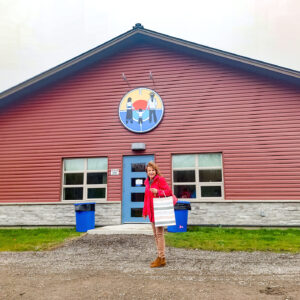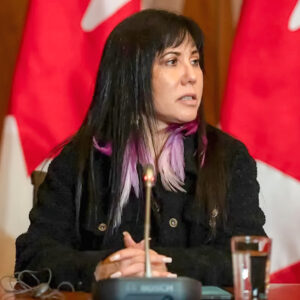
SIX NATIONS – Francis “Flower” Doxtator has been waiting for her ship to come in for three years, since her name was anonymously submitted and accepted by Earthship Biotechture, based in New Mexico, to receive a totally eco-friendly home built for her.
Since then, there have been more than a few roadblocks to be cleared out of the way, which had left Doxtator feeling less than confident the project would materialize at all.
But on Monday morning, a small army of around 70 volunteer workers from around the world, along with Brantford and Six Nations volunteers, poured onto her property, set up a tent village and almost immediately began work.





Their arrival was an emotional release for her and her family.
“I felt kinda numb when they started to come down my driveway,” said Doxtator from the middle of the bustling site. “There’s always been a bit of skepticism there. This is unbelievable. Who comes up to you and tells you they are going to build you a new home? How many people does that happen to?”
While still claiming support of the project, elected council decided collectively at a previous general council meeting that they could not offer official invitations to the 70 plus visitor and workers, thinking that potential liability issues while the workers are here might hold them responsible.
But Fran believes that doesn’t mean they cannot be here as her invited guests; however, it did create some concern that Band Council could prevent the project from happening.
“They’re just mad because I didn’t involve them or let them know that any of this was going on,” says Doxtator. “But no one is going to put a stop to it now.
“I have been around that housing list twice,” she says. “How do you go from number 23 on the waiting list for a new home, and three months later you’re 189 on that list. I’ve had it with trying to work within their system.”
Like honey bees, the work team swarmed a small hill located behind Doxtator’s time-warn trailer home on Sixth Line Road and almost immediately began an amazingly co-ordinated effort to build Fran’s Earthship.
Amongst those working and overseeing the project is Earthship Biotecture creator and founder Michael Reynolds of New Mexico. Reynolds has been building Earthships and perfecting its ecofriendly and self-sustaining technology since the 1970s.
“I think that when people start to understand these homes, and like them, we then use 80 to 90 per cent less fuels in Canada,” says Reynolds of his creations. “That in itself is a big thing. When people are comfortable they are happy. There is no real down side to trying to make this happen. It also repurposes hundreds of tires that we don’t have to burn and pollute the air. Every way you look at it, it’s positive.”
Also getting his hands dirty was Rob Feagan, a professor at Wilfred Laurier University in Brantford.
“I do a lot of community development kind of work with a focus on shelter and social justice,” he said. “When I read in your paper that an Earthship was being built here I wanted to help. I have studied the earthship idea for years and I found it a little different than the Habitat for Humanity work I do in El Salvador and other parts of Canada.”
Feagan said he was also interested in being a part of building bridges with Six Nations in recognition that ally-ship.
“That is a very important part of what I need to be doing, helping to facilitate my students in their learning,” he says. “There is a real sense here of contributing something to a better world, even if it’s just one house. But this idea can ripple out and play a role in perhaps other First Peoples across Canada.”
He has found an immediate affinity with Flower.
“Flower is just a fabulous woman,” says Feagan. “She was very emotional when we came and really loves the fact that we are here. It was a really beautiful moment.”
“There is a real sense of contributing something to a better world, even if it’s just one house. But this idea can ripple out and play a role in perhaps other First Peoples across Canada,” he says.
Project co-ordinator, Deborah Binder is originally from the Virgin Islands, Spain, and is an old hand at keeping Earthship projects on time and on budget.
“We have done projects in Canada before but they have been private homes for people, but this is the first time we are doing a humanitarian project like this,” says Binder. “We have been wanting to do something for First Nations for years because of the housing crisis’ on reserves. We are hoping this will be the first of many more similar projects.”
Many crew workers have built conventional homes through “Habitat-for-Humanity” type projects, Others, building Earthships around the world.
“In India and the Philippians, they welcome us with open arms and want to know what they can do to help us,” says Binder. “But here is North America and some places in Europe, it is much more difficult.”
Donations will still be needed to complete the Six Nations’ project to a higher standard.
“We have a very tight budget now and we can do it with that budget, but the more money we have to work with, better the systems are going to be,” says Binder.
One such upgrade from the basic unit was the toilet facilities.
“We talked about it yesterday and decided that since it is for Flower and her five grandchildren, she really needs the upgrade which is an extra $500 for example.”
Donations can be received either through biotectureplanetearth.com, or by dropping by and leaving a donation and a tax receipt.
Terri-Lynn Brant is acting as Six Nations co-ordinator for the project and led the group in an opening address Tuesday morning.
“I am very thankful to her that she is going to help me set up and look after the workers,” says Doxtator.








